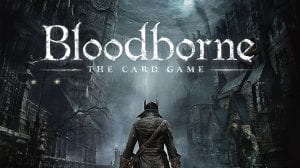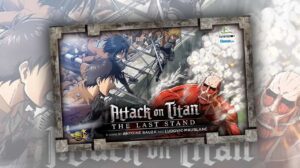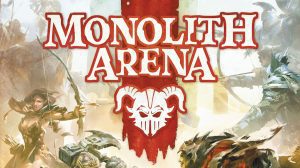I’m no stranger to grid-based one versus one gaming. In my early tabletop gaming days, these games were like a steak to my diet. I loved them to bits, and I tried many variations. Just like steak, most of them were pretty terrible, but I did discover underrated gems such as Stonebound Saga. Token Terrors is the latest one versus one skirmish game I’ve played where players mix factions to create their little army on a simple grid. It promises an experience that is a mixture of Chess and Magic the Gathering. We are going to see if it matches up with that image.
Before we continue, a bit of disclosure. At the time of this writing, this game is not on Kickstarter, and I did not receive any physical prototype. I’ve played this three times on Tabletop Simulator (it is public) against the designer. I beat him twice. Let’s do this.
Both you and your opponent are Warlords. For some reason, you want to eliminate your opponent and the best way to do that is to completely eradicate their entire army. We’ve all seen this scenario before.
At the start of the game, you will draft your army. There are six factions, such as Elves and Soldiers, equipped with a pair of rule-breaking Talents for you to mess around with. When you select a faction, you can take up to 6 tokens of that faction, minding the 10 token limit for your entire army. For example, if I enlisted the Goblins, I can take 3 Goblin tokens if I wish. Once a faction has been selected, your opponent cannot pick that faction. The drafting continues until you and your opponent have 10 tokens.
Once the drafting is completed, both you and your opponent will place five tokens on the board. The rest will go into the Reserve. Now let’s get into the interesting bits.

Tactical Dance Moves
On your turn, you are going to pick one token and activate it. You have 3 Command points to spend on various actions. “Move” is what you think it is except you can’t move diagonally. “Battle” is just as straightforward as it sounds. “Talents” allow you to use the token’s pair of faction abilities that break the rules of the game. “Enrage” increases your token’s Threat by 1.
Threat? It’s one of the most innovative features I have seen in a while. Every token has a threat of 1, which represents the health and damage of that token. To boost your threat, you must put your token adjacent (not diagonal) to other tokens of the same faction. If I want my Elf token to have a threat of “3”, I would need two Elf tokens adjacent to it.
What this mechanic does to the “meta” of the game is it enforces the importance of positioning and movement. It also makes combat engaging since you are always looking for the weakest link in your opponent’s formation that would collapse their entire position. Because of this high importance of positioning, the fight feels less like soldiers diving into a blender and more like two fencers watching every muscle of their opponent’s movement, ready for that calculated thrust.
You get the typical ranged and melee attacks, but with a different approach. Melee attacks are non-diagonal adjacent squares, and ranged attacks are non-diagonal with a Range of two. That’s not the twist here.
Every single type of attack has a “powered” up version of it by spending 2 command points instead of 1, kind of like going for a haymaker instead of a jab in a boxing match. In melee attacks, this leads to a “blindside” strike where you attack diagonally. That’s important because the defender always strikes back but only to non-diagonal attacks. Ranged attacks not only have to worry about counter-attacks but evasion as well.
How do you evade? Roll a six-sided die. Unlike melee attacks, ranged attacks can fail. Yes, this chess-like game does have a randomization portion, and it is one of the best solutions to a common problem. Ranged attacks in grid-based games tend to be a center of controversy or balanced in a predictable fashion. Usually, it involves making ranged not deal threatening damage, or make the unit not very mobile as compensation for their inherent advantage.
Good Use Of Dice
In this game, evasion is a 50% chance dice roll meaning there is now a risk management layer to consider when going for a ranged assault. The improved version of this attack is “Sure Shot” where your opponent must roll a 6 to evade. A successful evasion not only negates the damage but allows the target to move up to 1 to 3 spaces without spending any command points, giving your opponent a nasty opportunity to counter-attack. It is an excellent compromise that forces you to evaluate the situation and gives you ownership for any potential failures. You knew the odds so don’t blame the dice.
All of this sounds good, but it still isn’t enough to stick itself out. This is where Surge points come in. At the start of the game, you have one Surge point. You gain more by spending 3 Moves without backtracking (also known as a “dash”) or Rest the activated token at the end of your turn. Resting makes your token vulnerable to ranged attacks since they cannot roll evasion.

Surge points is a spendable resource that you use to issue more commands beyond your starting 3. This opens a cornucopia of options since you can perform some big plays and adjust your strategy on the fly without severe restrictions. You can defensively play the game to garner surge points, but you are giving your opponent a superior position making their shell harder to crack. Or you could try a more balanced approach where you take potshots at your opponent’s position while slowly gathering surge points to counter their potential strikes.
To keep the game tight between you and your opponent, you are also allowed to reinforce. Before you end your turn, if you have less than 5 tokens on the field, you are allowed to place tokens from your reserve to the outer edge on the board until you have 5 tokens. That also includes your opponent’s side, which shocked me too. Much like everything else, this is a clever solution to a “snowball” problem that often plagues this genre.
So I said a lot of good things. Brilliant things even, but I’m still a critic here. Every inch of cardboard is examined here. It is time to put on my critic hat and try to cover this birdnest hair of mine due to this wonderful quarantine.
Needs A Tad Bit More Meat
Let me get one thing straight before I go into this: This is an excellent system for a lightweight 1 vs 1 game that plays well within an hour. I have played many skirmish games such as Onitami, The Duke, and Krosmaster Arena. Token Terrors offers a unique spin to the genre while solving many issues without comprising simplicity. Once you wrap your head around the “Threat” mechanic, the rest of the game is engaging without stuffing your face full of complexity nonsense.
I just wish the “Season 1” factions were a little more interesting. They don’t show the muscles of this system.
As I briefly mentioned, there are Talents in this game. Every faction has two, and they highlight the overall strategy of that faction. For example, the Elves have “Teamwork” and “Sharpshooter” talents. Teamwork allows you to move another elf unit (the one not activated) to move several spaces while Sharpshooter allows the next ranged attack to be performed diagonally instead of in a straight line. Based on this, you can tell that this faction is focused on odd angles and would likely be in a checkmate situation if they control the middle.
The issue is that most factions, like the Elves, are either “move other units” or manipulate threat and range attacks leading to very linear tactics. I’m not saying these are poorly designed, as they serve as a perfect bedrock for understanding the game, but the Season 1 set feels a little too safe for me. I’m not harping on this hard as I should since other expandable skirmish games fall into the same trap as well, but I was hoping this wouldn’t follow the status quo. Future expansions will obviously fix this issue in the long run but this might be a problem for some of you.
This isn’t to say every faction is like this. In the Season 1 package, there are two factions that break this: Zombies and Flying Machines. Flying Machines have a talent that allows adding one of their tokens to the field, breaking the 5 token field limit. Zombies have the power to infect, meaning when they kill an opposing token, they add a zombie token from the graveyard to the reserve. In other words, anyone with the Zombies faction might go beyond the 10 token limit in an army. It’s these types of weird talents that demonstrate how far this system can go.
I also wish that some factions didn’t rely on groups. I know that’s a contradiction to the Threat mechanic, but this does limit what you can draft. Since you need your tokens to be in high numbers to be intimidating, it means very few options in drafting outside the usual two factions with one range and one melee. An easy solution to this would be expensive “elite” tokens that can stand well on their own or more factions that don’t rely on huddling groups to be effective.
Outside of those concerns, this is a game worth looking at. It’s a very lightweight game that offers a surprising amount of tactical decisions shrouded in a skinny rulebook. As someone who tends to play these games often, I’m very impressed by the presentation here. It’s something unique and executed well in a flooded market that will only improve as expansions are released.











